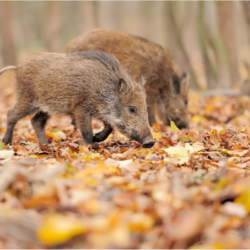Animal mange, also known as scabiosis, is a parasitic skin disease caused by microscopic mites of the genus Sarcoptes. Although this condition is mainly seen in domestic animals such as dogs, cats, rabbits and rodents, it presents a significant zoonotic risk, which can be transmitted to humans. The mites responsible for scabies burrow under the skin, causing intense itching, redness and skin lesions.
Animal scabies is not considered a contagious disease, nor is it notifiable. In terms of public health, it is not a notifiable human disease. The authorities do not recognise animal scabies as an occupational disease, unlike human scabies, which is listed in table RG 76 of occupational diseases. Article R 231-61 of the French Labour Code does not classify mange agents as biological agents.
What is the pathogenic agent?
Animal scabies, also known as scabiosis, is an infectious skin disease caused by parasites of the Sarcoptidae family , which includes the genera Sarcoptes, Notoedres and Trixacarus. This skin condition is caused by a microscopic mite, the sarcoptes (Sarcoptes scabiei), which can be divided into several subspecies specific to different animal species: hominis for humans, canis for dogs, ovis for sheep, equi for horses, cati for cats and cameli for camels.
Scabies is a benign contagious disease whose main symptom in humans is itching. The parasite, measuring 200 to 350 μm, mates on its host. After fertilisation, the female burrows into the stratum corneum of the epidermis, where she lays three to five eggs a day. The eggs hatch in three or four days, producing larvae that become nymphs and then adults in around two weeks. The entire parasite cycle lasts around twenty days.
Sarcoptes scabiei var. hominis is an obligate parasite of humans and does not survive for more than a few days in the environment. Mated females are essentially the main vector for the transmission of scabies, while larval forms rarely play this role. Ninety-five percent of scabies is transmitted by direct skin contact, and rarely through clothing or bedding.
In animals, transmission often occurs through direct contact with an infested animal or through the contaminated environment. Animal scabies requires treatment with antiparasitic drugs and strict management of environmental hygiene to prevent the spread of this zoonosis. Pet owners must therefore be vigilant and adopt preventive measures to protect their health and that of their pets.
What does the disease look like in animals?
The species that can be infected by scabies that can be transmitted to humans mainly include farmed rodents and pets such as dogs, cats and rodents. Scabies has a worldwide distribution and is highly contagious within the same animal species. Transmission occurs mainly through direct contact with an infested animal and, in some cases, through contact with contaminated livestock equipment or premises. Symptoms include itching, crusting and hairless areas on the skin of affected animals. To prevent and treat mange, rigorous hygiene measures and anti-parasite treatments are essential.
Dog scabies
Canine sarcoptic mange is caused by the mite Sarcoptes scabiei var. canis. Red foxes are currently a major source of infection, particularly in urban areas. Dogs can become infected through direct contact or via a contaminated environment.
Signs of mange in dogs include intense itching, crusting, dandruff and hair loss, especially around the ears, elbows and hocks. Severe forms can lead to generalisation throughout the body, accompanied by weight loss and lethargy. Diagnosis often requires microscopic examination of the mites, although the results may be negative. A blood test can detect antibodies against the parasite, but is not infallible.
Sarcoptic mange is highly contagious. Treatments include effective, easy-to-use anti-parasitic drugs. It is crucial to treat all pets in the home to avoid re-infection.
Contagion to humans is possible, with around 30% of cases showing red, itchy skin lesions, particularly on the forearms and abdomen. Dog sarcoptes do not reproduce in human skin and die after a few weeks. Human rashes heal on their own once the dog has been treated.
Diagnosis is based on history, clinical signs, microscopic examination and response to treatment. In an indoor environment, the sarcopte survives only a few days without its host. Simultaneous treatment of all dogs is essential to eradicate the infestation.
Cat scabies
Sarcoptes scabiei can sometimes infect cats, but this is rare. The main agent of cat scabies is Notoedres cati, which is still present in some overseas departments and neighbouring countries such as Italy. Notoedric mange mainly affects the head, with hair loss and thick scabs around the ears, face and neck, accompanied by severe itching.
The diagnosis of notoedric mange must rule out other skin diseases such as allergies and ringworm. This is done by observing the parasites under the microscope, which are generally numerous and easy to identify. A suitable treatment is then prescribed by the vet.
Humans can contract scabies through direct contact with an infested cat, developing skin lesions and itching, but this infestation is temporary. Cat scabies is a contagious disease caused by mites, which is benign but can lead to complications if left untreated.
The most common form of mange in cats is ear mange, caused by Otodectes cynotis. This parasite lives in the auditory canal and can lead to ear infections and perforation of the eardrum. Cats can also suffer from notoedric mange, which is rare in France but common elsewhere, and can be transmitted to humans. It starts around the ears and spreads to the head and then to the rest of the body. In the case of ear mange, the cat frequently scratches its ears and shakes its head, with the presence of dark earwax and an unusual odour. Monthly antiparasitic treatment is essential to prevent these diseases.
Sarcoptic mange, caused by Sarcoptes scabiei, is more common in dogs. All forms of mange cause intense itching (pruritus), making the cat restless and leading to skin lesions, scabs, pimples and hair loss (alopecia). The skin may thicken (lichenification).
Horse mange
Horse mange, a highly contagious parasitic infection, needs to be taken seriously. Three types of mite burrow under the horse’s skin, causing severe itching. There are three types of mange, depending on the areas infected: sarcoptic mange, psoroptic mange and chorioptic mange. Scabies is a zoonosis that can be transmitted to humans, so strict health precautions must be taken when treating an infected horse.
Sarcoptic mange affects the head, withers, neck and shoulders. Caused by sarcoptes mites, it causes scabs and lesions, leading to intense itching. If left untreated, the mites multiply and scabies can spread throughout the animal’s body.
Psoroptic mange is less serious, caused by psoroptic mites. It often occurs in winter, affecting the mane, the base of the tail and sometimes the ears. The hair becomes brittle, and the horse experiences intense pruritus.
Chorioptic mange mainly affects the horse’s limbs and is caused by chorioptic mites, which are active in spring. They live on the surface of the skin, causing intense itching on the pasterns and fetlocks. Horses may bite themselves and stamp their feet to alleviate the pain, leading to lesions and scabs.
In the event of pruritus, lesions or hair loss, it is vital to consult a vet and isolate the animal. Because scabies is so contagious, it must be reported to the authorities. All horses that have been in contact with the infected animal should be treated preventively. The stable and all associated equipment must be thoroughly cleaned. Hygiene precautions are essential to prevent transmission to humans: wear gloves, wash hands and avoid contact with children.
How is the disease transmitted?
Scabies is transmitted by direct contact with an infected animal, particularly in the case of certain types of guinea pig, rat, cat (French overseas departments and territories), hamster and young dog scabies. People infected with animal scabies do not transmit the disease to their family or professional contacts.
Animal scabies has a worldwide distribution and is less frequently transmitted to humans than human scabies. Professional activities at risk include all those involving close contact with infected pets or domestic animals, such as animal keepers, breeders, vets and staff at rendering plants.
Human scabies is transmitted mainly through direct contact between hosts, often during sexual intercourse, making it a sexually transmitted infection (STI). It can also be transmitted indirectly via the contaminated environment (linen, clothing, bedding, furniture). The factors that encourage transmission are close contact, living in a community and social insecurity.
The human variety of the sarcoptes cannot develop on pets, but they can be potential vectors. The other animal subspecies of the sarcoptes can start their development on humans, but cannot maintain themselves there. Scabies is transmitted mainly by direct physical contact, with an increased risk in the presence of heat and humidity.
Inert objects can contaminate, but this contamination remains limited given that the parasite only survives a few days outside the skin and succumbs at a washing temperature exceeding 55°C.
Specific forms of mange found in animals can transmit infection to humans, but the human immune system rapidly eliminates animal parasites, inducing minimal symptoms in humans.
What are the symptoms in humans?
Infestation by a non-human-specific sarcopte is responsible for pseudo- mange, characterised by localised pruritus with no specific lesions. Symptoms of scabies include intense itching leading to scratching lesions on areas of contact with the infested animal (arms, legs), which disappear after medical treatment. It is also crucial to treat or remove the animal. The average incubation period is one month, varying from two to six weeks, but in the event of re-infestation, this is reduced to one to four days due to prior sensitisation.
Scabies manifests itself as progressive pruritus of variable intensity, particularly in the evening and at night, sparing the face. This pruritus is due to an immunological reaction to the droppings of the sarcoptes. Several physical signs specific to scabies may be present:
- Scabious furrows: red, sinuous, thread-like lesions measuring a few millimetres, often terminated by an acinar eminence (discrete elevation), corresponding to the path and position of the sarcoptes, mainly on the hands and wrists.
- Beaded vesicles: translucent elevations on an erythematous base, mainly on the hands and wrists.
- Scabious nodules: red or coppery-brown papulo-nodules, infiltrated on palpation.
Non-specific signs often accompany these manifestations: urticaria, scratching lesions, eczematisation, excoriations, prurigo, even impetiginisation. These lesions have a suggestive topography: interdigital spaces of the hands, anterior surface of the wrists, elbows, roots of the arms, umbilicus, buttocks, inner surfaces of the thighs, external genitalia in men, nipples and areolae in women. The back, neck and face are generally spared.
Atypical forms of scabies
There are several less common forms of scabies:
- Infant scabies presents a deceptive symptomatology, with irritability, restlessness and anorexia, often without pruritus or specific lesions. Lesions may extend to the face. Evocative signs include vesicles or pustules on the palms and soles, and papulo-pustular or nodular lesions under the armpits.
- Pauci-symptomatic (or invisible, or “clean people’s”) scabies manifests itself as pruritus without skin lesions, and is observed in people with meticulous hygiene.
- Profuse (or disseminated) scabies causes numerous diffuse lesions, including on the back. It may be associated with chronic illness or treatment with dermocorticoids.
- Hyperkeratotic (or “Norwegian”) scabies, described in Norway in 1848, is characterised by discreet or absent pruritus and hyperkeratosis, possibly with erythroderma, affecting the entire body surface. It develops mainly in the elderly and immunocompromised patients.
These forms of scabies require special attention for diagnosis and treatment. Infant scabies can be difficult to diagnose because of the absence of classic signs, and pauci-symptomatic scabies can go undetected without visible lesions. Profuse scabies requires rigorous management due to the widespread dissemination of lesions, and hyperkeratotic scabies requires intensive treatment due to its widespread impact and predilection for vulnerable individuals.
Good personal hygiene, careful observation of symptoms and prompt consultation with a healthcare professional are essential for effective management of these forms of scabies.
How is scabies diagnosed?
Several specific examination techniques can be used to diagnose scabies:
- Ink test: This technique helps to identify scabious furrows. Ink is applied to an area of suspect skin, then alcohol is used. Only the furrows remain coloured, which can guide a skin sample.
- Dermatoscopy: Used to quickly confirm the diagnosis. A magnifying system applied to the skin is used to visualise the anterior end of the parasite, known as the ” hang-glider sign “.
- Blood tests: Eosinophilia may be detected, especially in profuse forms.
A direct parasitological microscopic examination can be carried out on a sample taken from a scabial furrow or desquamation. After scraping the area with a vaccinostyle, the sample is placed on a slide with a drop of immersion oil for observation under a microscope at low magnification. This technique makes it possible to identify the adult parasite, a larval form, eggs or even excrement. This is difficult to detect except in profuse or hyperkeratotic forms.
Other, less cost-effective sampling techniques can also be used to identify the sarcoptes under the microscope, such as the scotch-test or skin biopsy. It is also possible to test for sarcoptes DNA using PCR. The skin biopsy most often shows a non-specific delayed hypersensitivity reaction with an infiltrate of mononuclear cells (macrophages, lymphocytes) and eosinophilic polynuclear cells with spongiosis (intercellular oedema).
The differential diagnosis includes other generalised pruritic dermatoses: atopic dermatitis, lichen planus, generalised eczema, prurigo, senile pruritus, lymphoma, pediculosis corporis, bullous pemphigoid, psoriasis (in the case of hyperkeratotic forms), pruritus of metabolic origin (cholestasis, renal failure), drug-induced or psychogenic origin.
How is it treated?
There are a number of acaricide products available, for general (oral) or local (cutaneous) use. These drugs are neurotoxic to the parasite, causing paralysis and death at all stages of development.
Used in veterinary medicine,Ivermectin is the only oral medication available to treat human scabies. Marketed under the name Stromectol, it acts on adult sarcoptes. A single dose of 0.2 mg per kg of body weight is recommended, with a possible second dose after 8 to 15 days.
A pyrethroid drug, Permethrin is applied to the body (except the head) in the form of a cream. In France, permethrin is marketed under the name Topiscab, and is recommended for children aged 2 months and over and for pregnant women. The cream should be left on the skin for 12 hours before washing. Benzyl benzoate, used historically, is marketed under the name Ascabiol. As a whitewash, it needs to be applied again after 8 days if necessary.Esdepallethrin/piperonyl butoxide-based sprays (Sprégal) are applied to the body, avoiding the face. This treatment is contraindicated for asthmatics.
Essential oils offer promising alternatives. Among these,tea tree oil and neem oil have been shown to be effective in vitro. Other oils, such as those containing eugenol or citral ( clove oil, citronella oil), are also considered effective. Studies have shown that tulsi basil and Ceylon cinnamon essential oils are particularly effective against sarcoptes. However, the lack of in-depth clinical research and reduced commercial incentives limit the use of essential oils. These substances are in the public domain. Although these alternative treatments have the potential to be useful, there is still insufficient evidence of their safety and efficacy.
How can contamination be prevented?
For general hygiene, clean and disinfect premises and equipment in accordance with the “list of authorised disinfectants” on the Ministry of Agriculture website. Collective preventive treatment is recommended when animals are gathered together.
Training and information for employees is essential in terms of scabies risks, hygiene and prevention measures. Make sure you provide drinking water, soap, paper towels and a first aid kit. Separate lockers for street clothes and work clothes are necessary to avoid contamination. Workers must use work clothing and personal protective equipment appropriate to their task. The latter must be in good condition and properly maintained.
In the event of animal illness, improve hygiene on the farm and isolate sick animals. Treat all animals of the same species. Wash and disinfect contaminated sites and reusable equipment. Wash your hands systematically after contact with animals, waste or droppings, and before meals, breaks or the end of the working day. Do not drink, eat or smoke in the workplace.
In the event of a wound, wash, soap, rinse, disinfect and cover with an impermeable dressing. Regularly clean work clothes, gloves and boots. Change your clothes at the end of the day.
If you detect mange on an animal, consult a vet to identify the agent responsible and follow the collective control measures. Limit contact with affected animals and their equipment, wear gloves and wash your hands after contact.
The rendering service should be informed of the presence of mange. Wear personal protective equipment and follow hygiene instructions.





